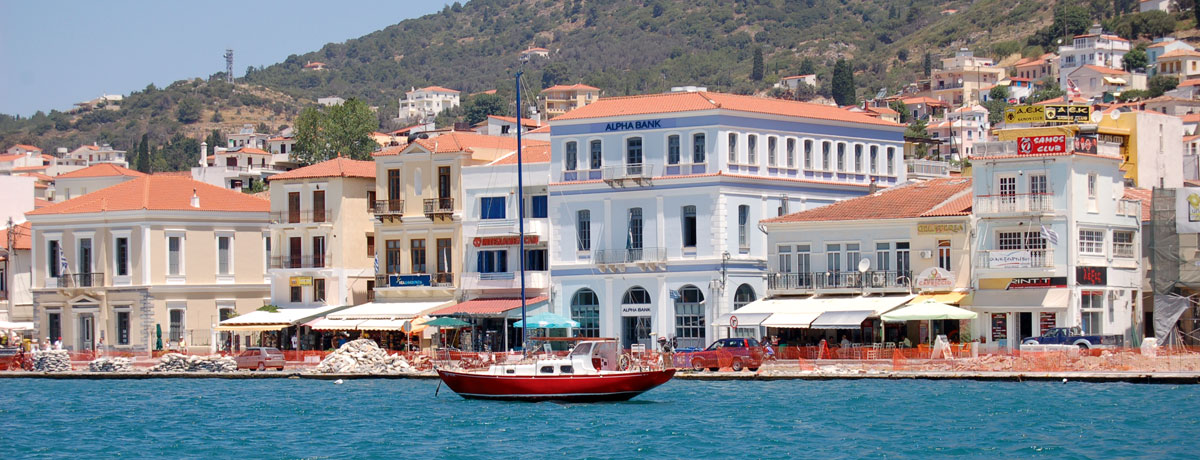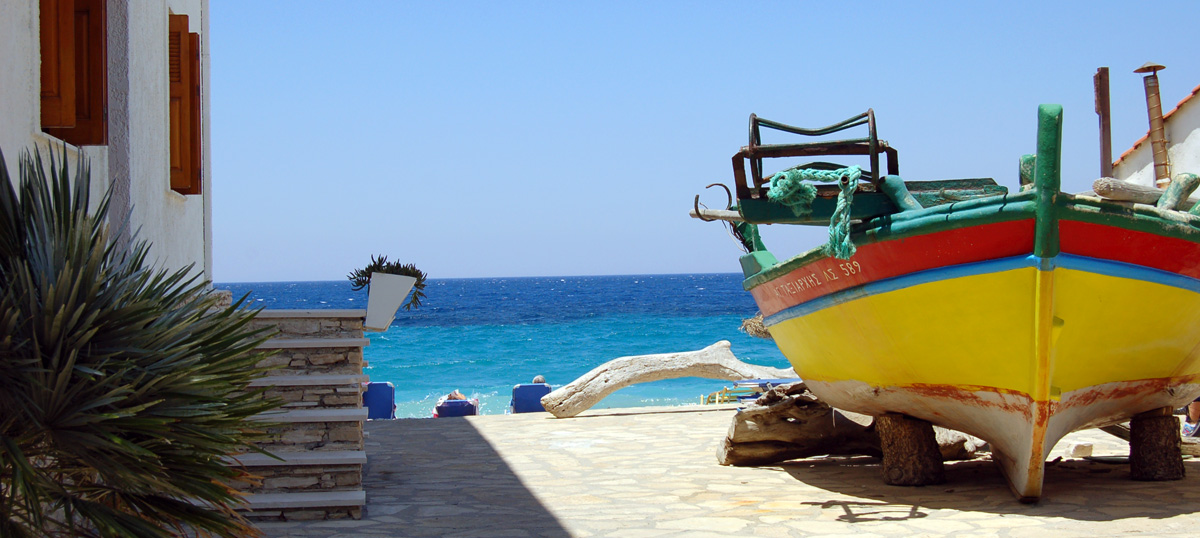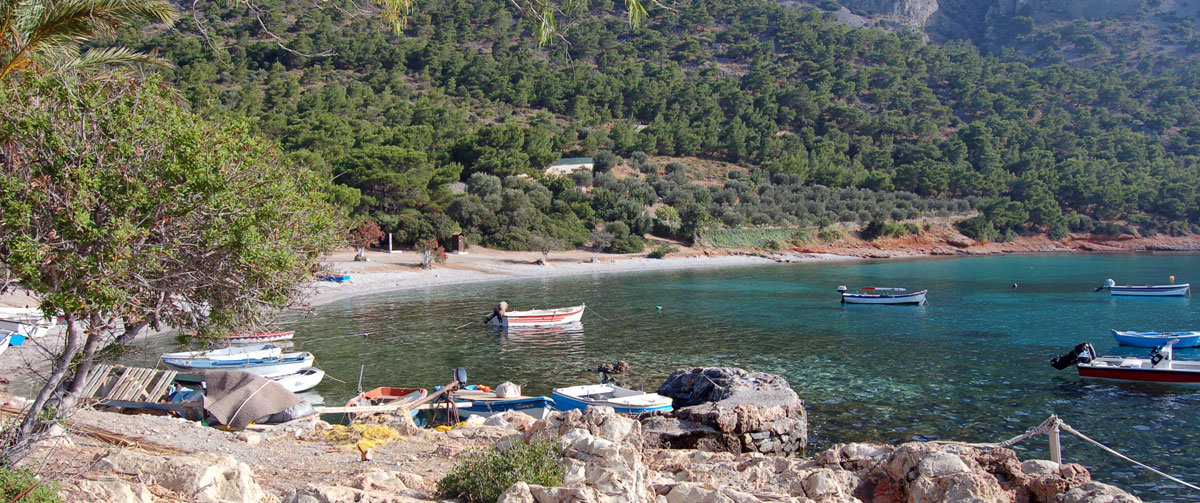
The name of the island is pre-Hellenic and means “tall” and was so called because of its tall mountains. During antiquity the island was also known as ANTHEMOÚSA (meaning “many flowers”), DRYOÚSA (“rich in water”), MELÁMPHYLLOS (“rich vegetation”), IMVRASÍA (in honour of the goddess Hera) and also “Nísos ton Makáron” (“Island of the very happy”).
Sámos, member of the Ionikís Dodekápolis (Twelve Towns of Ionía), has been continually inhabited since 5000BC. The founder and settler of the island is, according to the ancient writers, Angaíos from Arkadía in the Pelopónnisos (helmsman of “Argó” during the Argonautical Expedition), whose son was the hero Sámos. The Iones colonised Sámos in 900BC and the island flourished during the 7th and 6th centuries BC. The island’s own coinage was circulated from the early historical years and it appears to have been a radiant centre of Ionía. Heródotus, the father of history, wrote that it was the first of all Greek and barbaric towns (its population reached 100,000).
A yearning to be different and a tireless pursuit of invention would distinguish the islanders. They built ships (called “Sámaina”), which combined capacity with speed. They were involved in all sea battles. They were among the first to be seasoned sailors on the passage to the Egyptian Sea. Kolaíos the Sámian was the first to discover the Herculean Pillars (Gibraltar) and brought back to Greece geographical knowledge of new countries and the phenomenon of tides (Heródotus). The artists Roíkos and Theódoros invented the pouring of bronze into moulds to make statues (8th century BC). The painter Savrías conceived the concepts of shade and light and the architect Mandroklís built the Vósporo bridge, for the passage of the troops of King Dareíos of Persia (late 6th century BC). Kallístratos originated the Ionic alphabet with 24 letters. Doctor Erasístratos (3rd century BC), who specialised in anatomy, was the first to practise the method of dissecting bodies for research. The philosopher Mélissos (5th century BC), who as Sámian Admiral defeated the Athenian fleet of 440BC, co-wrote the treatise “Perí tou Óntos” (Regarding Existence).
This brings us to two great figures, whose eminence is still apparent today world-wide, the father of mathematics and great master of learning Pythagóras (6th century BC) and the great astronomer and scholar of trigonometry Arístarchos (3rd century BC), who discovered that the sun was the centre of our solar system (Copernicus re-iterated this in the 16th century.) During the days of the fiendish tyrant Polykrátes, who governed for 40 years, Sámos reached the apex of its glory. The first manmade harbour in Greece was built, whose 480m long breakwater completes the base for today’s breakwater, the town was enclosed by a 6400m long wall of thickness 4.5m, the Evpalíneio Trench was built (the miracle of boring a hole through the mountain for the transportation of potable water), the Iraíon, the largest Greek temple according to Heródotus, was constructed (temple in honour of goddess Hera) and there was no end to the great works.

The fleet (150 ships) constructed in Sámos ruled the waves of the Aegean, allowing no ship to pass without paying a toll. Sámos, during those days, was the state capital of island and coastal towns. Its rule even reached to Egypt for 16 whole years. Unfortunately the brilliant Polykrátes imported the opulence and debauchery of the east, which went to undermine the state of Sámos. For instance, he demolished the arena, where the youth would exercise and in its place established the “Lávra” (narrow road) with many courtesans from around the world.
In 479BC the Sámians, as allies to the Greeks, took part in the battle of Mykális against the Persians. The historian Diódoros Sikeliótis (1st century BC) reported that the Greeks owed their most illustrious victory ever against the Persians to the Sámians. The island joined forces with the Athenian Allies in the 5th century BC and basked in such affluence and strength that the historian Thoukydídis wrote that they were on par with the sea state of Athens. The Sámians refused when the Athenians demanded subjugation taxes from their allies. An Athenian fleet with troops commanded by ten generals (Periklís, Thoukydídis and the tragedian Sophoklís amongst them) defeated the island’s fleet in sea battle, close to the island of Trigía (Samiopoúla). The siege of Sámos lasted 9 months, before succumbing to Periklís, who destroyed the town and put many inhabitants to death (439BC). Regardless the Sámians remained a most faithful ally to the Athenian.
The Great Aléxander used the island, because of it central position, as a base for his raids in Asia Minor. The Romans, who pillaged the island and removed its great works of art, used it in a similar way. Even Cicero, the greatest rhetorician of ancient Rome, protested and castigated such thefts. In 40BC the fleets of Anthony and Cleopatra sailed to the island and the two lovers relished their affair here (it is a fact that Cleopatra vacationed on the island). In 29BC, Emperor Augustus wintered his fleet in the favoured island of Sámos, granting the island many courtesies, including its liberty. In 70BC however, Sámos, together with other islands, made up a Roman province with capital N. Ródos.
During the Byzantine years the island was subjected to raids by the pirates, Huns and Goths and was conquered by the Saracens in the 9th century only to be liberated in the 10th, by the Byzantine General and later Emperor Nikifóros Fokás . After the fall of Constantinople to the Franks (beginning of the 13th century), Sámos changed hands between Franks-Byzantines-Franks, to be deserted after the fall of Constantinople to the Turks (mid 15th century), as the islanders could not stand any more plundering raids. (the few that remained dwelled in the caves of the high mountains).
The island remained deserted for a century but from the mid 16th century, thanks to the Turkish Admiral Kilitz, not only did some of the old inhabitants return but people from the rest of Greece and Asia Minor came with them (this is why for example we have the village of Mytilinioí from Mytilíni of N. Lésvos and the village of Pýrgos from Pýrgos of the Pelopónnisos).
The island was again at the trenches, rebelling against the Turks, during the Russian-Turkish conflict, but only enjoyed its freedom up until 1774. Sámos returned to slavery conditions but was the second island of the Aegean to rebel (17th April), after N. Psará, and take part in the Liberation Wars of the Greeks against the Turks of 1821. The Turks, who on the whole inhabited the capital of the island, were dispatched to the opposite coasts of Asia Minor. For 7 years Sámos battled to keep its freedom. The spirit of the fight was personified in their leader Lykoúrgos Logothétis, who organised a hierarchy that was unprecedented throughout the rest of Greece (History of the Greek Nation, Volume IB, page 125). Their resistance became proverbial. Place names such as “Kávo Foniás” (Murderer’s Cape) give the impression of the ruthless battles against the landed Turkish forces. They did not limit themselves to their island, but landed on the opposite coasts of Asia Minor and executed raids, resulting in driving the Turks inland. The Sámian successes emboldened neighbouring islands to rebel. The climax of the battle was reached on the 6th August 1824, when, under the command of Sachtoúris, the Greek fleet defeated the Turkish. Since then this day is celebrated each year on the island with many events.
Nevertheless with the London protocol (1830), signed by the three Great Forces (England, France, Russia), “Crete that bleeds for nine years, the untamed Sámos, the heroically resisting islands of Psará and Kásos” (History of the Greek National, Volume IB, page 542) are left out of the newly formed Greek State. And so the “protective” Forces hand over the “untamed” Sámos, where rivers of blood had flowed for almost ten years because of its resistance of being conquered and punished by the Turks, to them. Fortunately, though the island was under the power of the Sultan, it was only as a preferential province with a Principality Regime (the Governor was a Christian Sámian, appointed by the Sultan with a local government voted for democratically on the island, with its own flag, coinage etc.). This regime was dissolved in 1912, when the Sámians once again rebelled and reunited with Mother Greece.

Sightseeing
Visit the remarkable Monasteries of Zoodóchou Pigís (17th century) and Agías Zónis (17th century), as well as Moní Kótsika, where you will drink water good for the digestion from a well (you should take something to eat with you, as you will get hungry). The Monasteries are about 5km away.
The Archaeological Museum (22730 27469) with many remarkable findings that date from the prehistoric age, the Ecclesiastical Museum (22730 27312), the Library and Art Gallery (22730 28682) with its relics from the Wars of Independance (1821) and the Hegemony of Sámos, the Palaeontological Museum (22730 52055) in the village of Mytilinioí, with remains of rare animals (a unique giraffe that was given the name “Samothirío” stands out).
The monasteries of Panagiás Vrontianís (16th century, the oldest monastery, holds a great celebration with food, drink and dancing on the 8th September), Profítis Ilías (17th century with Byzantine hagiographies – celebrates on the 20th July), Evangelístrias, Ágios Ioánnis, Tímio Stavrós (16th century) and Megáli Panagía (16th century – with well-preserved murals – it is generally believed to stand on the site of a temple in honour of Artémida).
The Caves of Pythagóra (the father of mathematics hid in here before leaving for Greater Greece (Southern Italy), because he was opposed to the tyrant Polykrátes) and Kakopérato (with stalactites and stalagmites).

The island has amazing and excellent beaches, many all over the island. It is indicative that there are 3 beaches with the name “Psili Ammos” (thin sand). These beaches can be found all around, east to west, north to south, with furniture or as nature intended. At large, the south offers long sandy beaches, whereas the east has more pebbly waters and the north has a mixture of sand and pebbles.
Celebrations. The following days are all celebratory feasts: 30/1 Agíon Apostólon, 1/7 Agíon Anargýron, 20/7 Prophítis Ilías, 26/7 Agía Paraskeví, 27/7 Ágios Panteleímonas, 6/8 Metamorphóseis tou Sotíros, 15/8 Panagía, 27/8 Ágios Fanouríos, 29/8 Prodrómou, 31/8 Theotókou. Information from the Town Hall.
Flavours. You are on the island of the renowned “moscháto” (muscat) wine. Since antiquity the island is famous throughout the world for this variety. Mrs Stavroúla Kourákou informs in her article in the newspaper “Kathimeriní” that Sámos was recognised in the legislative decree of 1955 by the French Democracy as a “product name”, for the vin de liquer (VDR SAMOS). Don’t drink too much! Additionally, the “Híra” (widow) variety of ouzo, well known throughout the Aegean, is produced here (it is called “Híra”, as the widow of a distiller discovered the recipe). As regards to the food, the island’s speciality is stuffed goat, which is also the traditional Easter dish. If you happen to be there during a feast day, you should definitely try “yiortí” which will be offered (it is made in large pans from ground wheat, onion and meat). Also, do not forget to taste “boúknes” – figs the size and shape of pears, “hamádes” – a type of mature olive and the “moscháto” (muscat) grape.





